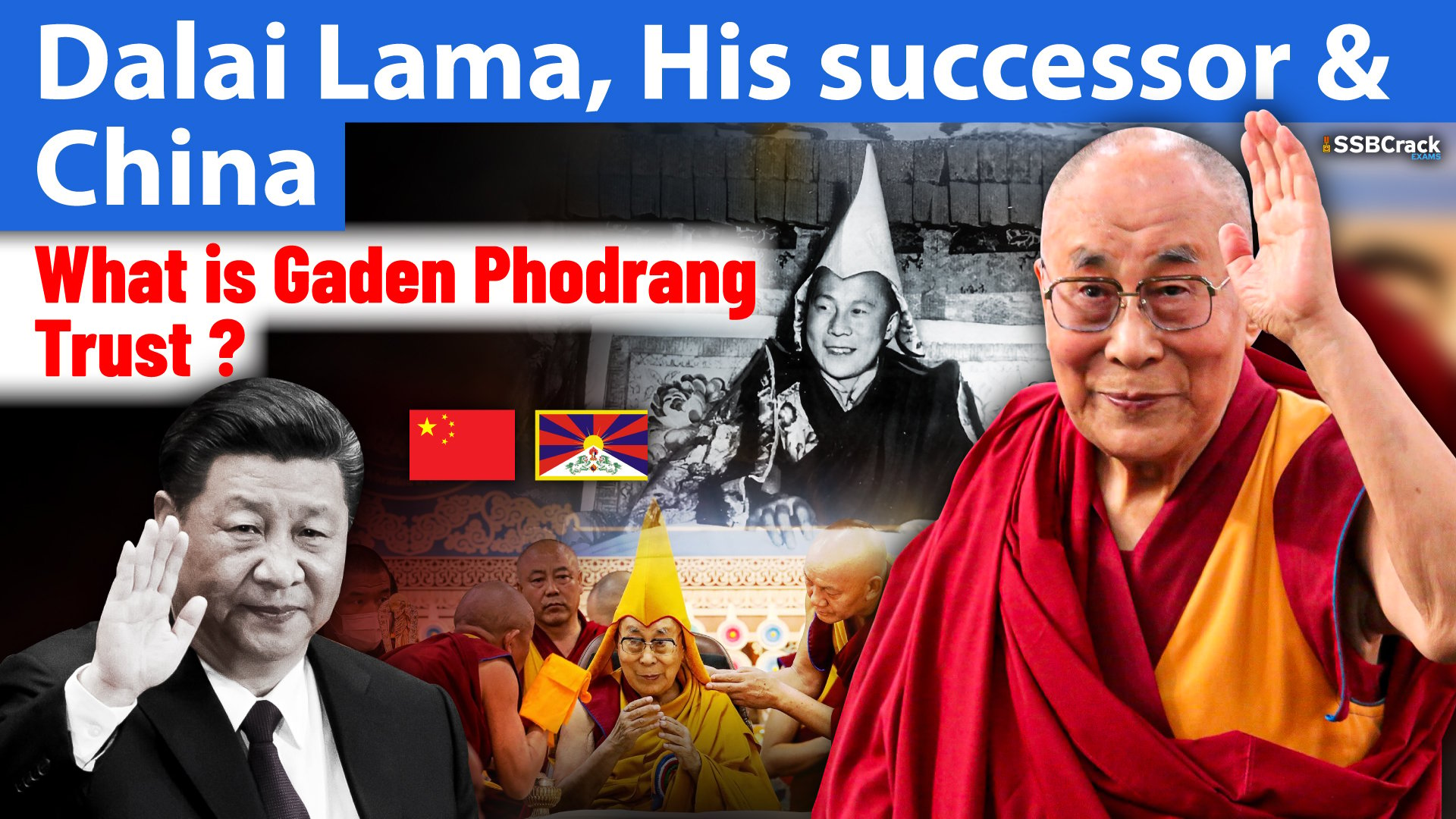The 14th Dalai Lama announced “that the institution of the Dalai Lama will continue” and that the Gaden Phodrang Trust shall be the “sole authority to recognize the future reincarnation”. “No one else has any…authority to interfere in this matter,” he said. The “Statement Affirming the Continuation of the Institution of Dalai Lama” came four days before the spiritual leader of Tibetan Buddhists turns 90.
Dalai Lama, His successor & China
Why In News
- The 14th Dalai Lama announced “that the institution of the Dalai Lama will continue” and that the Gaden Phodrang Trust shall be the “sole authority to recognize the future reincarnation”. “No one else has any…authority to interfere in this matter,” he said.
- The “Statement Affirming the Continuation of the Institution of Dalai Lama” came four days before the spiritual leader of Tibetan Buddhists turns 90. It is consistent with the statement that he made on September 24, 2011, that if it was decided at a future date “that the reincarnation of the Dalai Lama should continue and there is a need for the Fifteenth Dalai Lama to be recognized, responsibility for doing so will primarily rest on the concerned officers of the Dalai Lama’s Gaden Phodrang Trust”.
14th Dalai Lama
- Dalai Lama was born in the hamlet of Taktser in north-eastern Tibet — now Qinghai province of China — on July 6, 1935, and was identified at age 2 as the reincarnation of Thubten Gyatso, the 13th Dalai Lama.
- A year after the communists took power in China, the People’s Liberation Army invaded Tibet. In 1951, Tibet was annexed by China, and in March 1959, a Tibetan national uprising was crushed by Chinese troops. That month, the Dalai Lama escaped from Lhasa along with a group of his followers, and crossed into India at Khenzimane in Arunachal Pradesh. In 1960, Jawaharlal Nehru’s government settled him in McLeodganj, Dharamshala, where the Tibetan government-in-exile was established.
The Reincarnations
- Dalai Lama, literally ‘Ocean of Wisdom, is believed to be the manifestation of Avalokiteshvara or Chenrezig, the Bodhisattva of compassion, and the patron saint of Tibet. Bodhisattvas are persons who are on the path to becoming a Buddha, but who put the liberation of other sentient beings ahead of entering nirvana themselves.
- The institution of the Dalai Lama is part of the tulku concept in Tibetan Buddhism, in which spiritual masters are reincarnated upon their death, so that their teachings can be preserved and carried forward.
- The first Dalai Lama, Gedun Drupa, was born in 1391. Beginning with Lobsang Gyatso (1617-82), the fifth of the line, the Dalai Lama became both the spiritual and political leader of Tibetan Buddhists.
- The present Dalai Lama was found by a search party in 1939, six years after the 13th Dalai Lama Thupten Gyatso passed away in 1933. The reincarnation was recognised by several signs, including a vision revealed to a senior monk. In 1940, the little boy was taken to Potala Palace in Lhasa and officially enthroned.
What Is The Gaden Phodrang Trust
- The term Gaden Phodrang refers to the residential quarters of the Dalai Lama lineage from the second Dalai Lama onward at Drepung Monastery in Lhasa.
- After the Potala Palace was built (by a decree of the fifth Dalai Lama), the Dalai Lamas moved away from these quarters, and stayed at Potala Palace in winter and Norbulingka (built by the seventh Dalai Lama about 100 years after Potala) in summer. This tradition was followed until the 14th Dalai Lama’s escape from Lhasa to India in March 1959.
- One Of Three Institutions : Gaden Phodrang Trust is one of three institutions associated with the Dalai Lama. Penpa Tsering, Sikyong (President) of the Central Tibetan Administration (CTA), said: “There are three registered institutions that are related to His Holiness the Dalai Lama. There is Gaden Phodrang Trust, which is a registered body in India and operates from the office of His Holiness, there is another Dalai Lama Trust, which [too] is a non-profit organisation, and the third is Gaden Phodrang Foundation, which is registered in Zurich.”
- Gaden Phodrang Trust was registered in 2011 in Dharamshala with the aim of recognising the reincarnation of the Dalai Lama. It is based in the office of the Dalai Lama, and is managed by the former Kalon Tripa (head of the CTA) Prof Samdhong Rinpoche, a senior monk and a close confidant of the Dalai Lama. The Dalai Lama heads the trust, whose members include some other aides of the spiritual leader. “What His Holiness reiterated today is that the institution of the Dalai Lama shall continue as per the traditions and practices of Tibetan Buddhism. There will be a 15th Dalai Lama, a 16th Dalai Lama and so on,” Rinpoche said.
What Is The Gaden Phodrang Trust
- The foundation is a tax-exempt Swiss nonprofit with its registered office in Zurich, and is supervised by the Swiss Federal Department of Home Affairs. It is funded by charitable contributions made by the founder and the public.
- The Dalai Lama is the founder and president of the foundation, and Tseten Samdup Chhoekyapa (India), Kelsang Gyaltsen (Switzerland), and Jamphel Lhundup (India), are its co-vice presidents.
- The foundation says on its website that its aim is to maintain and support the tradition and institution of the Dalai Lama, and to promote basic human values, mutual understanding among religions, peace and non-violence, and protection of the environment.
- While it works to preserve Tibetan culture and support the Tibetan people, the foundation also helps others in need, regardless of nationality or religion.
- It seeks to promote better understanding between science and religion, supports efforts to provide access to knowledge from Buddhist science and philosophy, and funds a wide range of publications and translations.
Dalai Lama & China
- China denounces the 14th Dalai Lama as a “splittist”, “traitor”, and an exile with “no right to represent the Tibetan people”, and prohibits any public show of devotion towards him.
- In his 2011 statement, the Dalai Lama had said that his reincarnation should be found in a “free country, not under Chinese control”. He also said that “no recognition should be given to a reincarnation selected for political purposes by the Chinese government”.
- In his book, Voice for the Voiceless, published this March, the Dalai Lama said that his successor would be “born outside China”.
- There is fear among Tibetans that as the Dalai Lama grows older, Beijing could announce a successor of its choice, and use it to tighten its control over the Tibetan Buddhist religion and culture.
- In 2004, the Chinese government abolished the Religious Affairs Regulations that lay down the process for selecting the Dalai Lama, and in 2007 decreed that “No group or individual may carry out activities related to searching for and identifying the soul boy for the living Buddha without authorization.” A draw of lots, called the “Golden Urn method”, was institutionalised to select the Dalai Lama.
- In 2015, Padma Choling, a retired Chinese politician of Tibetan ethnicity and chairperson of the Standing Committee of the People’s Congress of Tibet, objected to the Dalai Lama’s insistence that no government had the right to choose the next Dalai Lama for political purposes.






























